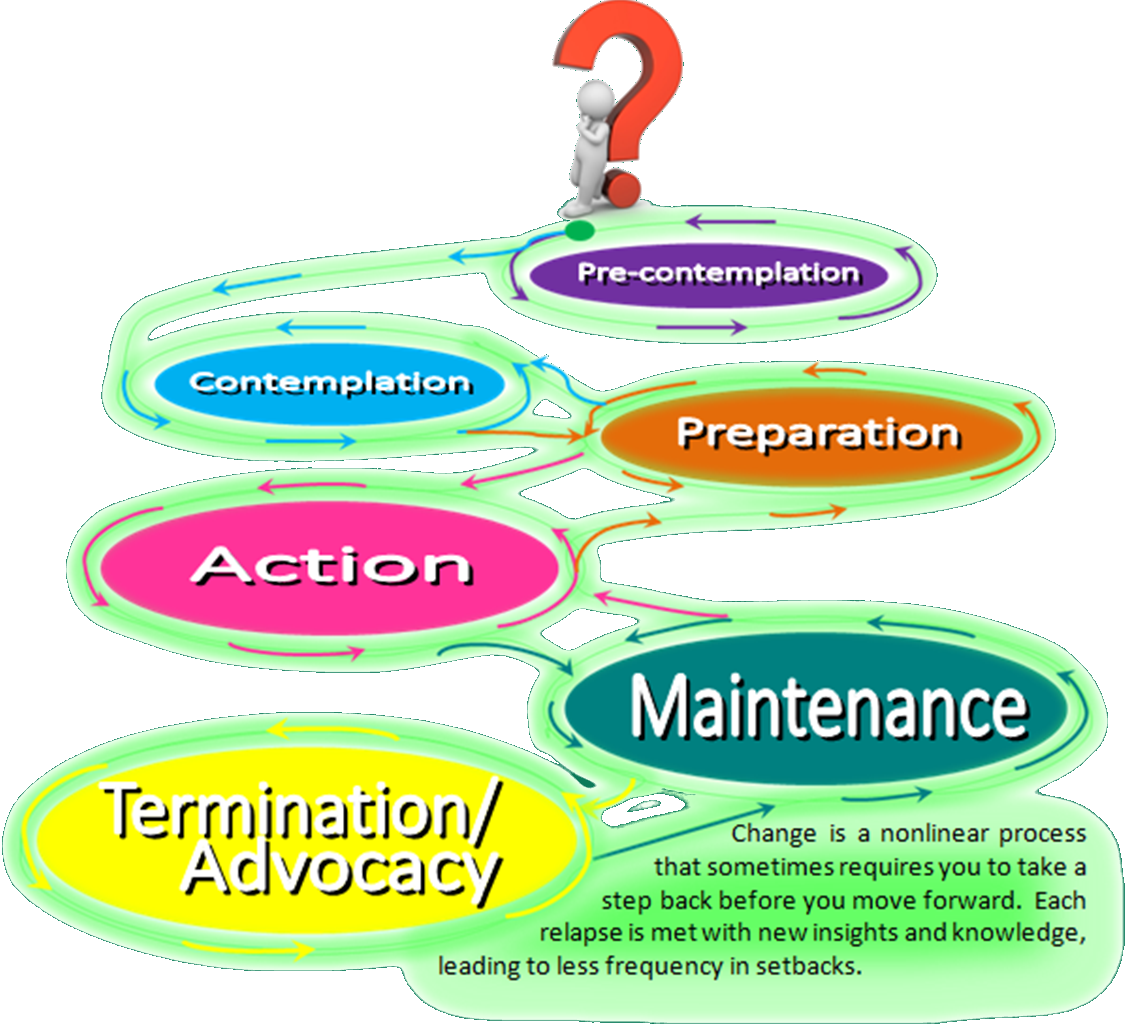 My readiness for change was never a fixed state of being. It, along with my motivation, varied considerably throughout the years, months, weeks, days, even hours. Identifying my position in the change process helped to bring greater understanding and more appropriate matching of support. Prochaska, DiClemente, and Norcross (1994) developed a model to explain this process of change. I constructed the image to the right to reflect this model and the cyclical journey it represents, as I found myself requiring several trips through the various stages to make lasting change. In this sense, lapses or relapses can really then be viewed as a normal part of the change process, as opposed to a complete failure.
My readiness for change was never a fixed state of being. It, along with my motivation, varied considerably throughout the years, months, weeks, days, even hours. Identifying my position in the change process helped to bring greater understanding and more appropriate matching of support. Prochaska, DiClemente, and Norcross (1994) developed a model to explain this process of change. I constructed the image to the right to reflect this model and the cyclical journey it represents, as I found myself requiring several trips through the various stages to make lasting change. In this sense, lapses or relapses can really then be viewed as a normal part of the change process, as opposed to a complete failure.
It may be valuable at this point, to spend some time exploring and reflecting on where you are currently at in the process of change and recovery. If you would like to undertake a quiz to help assess this, there is a basic one available by clicking on the link at Value Options.
Pre-Contemplation Stage
This stage is often marked by a lack of intention and increased resistance to change; denial that a problem exists; defence of current behaviour; and hopelessness. People in this stage may change if enough constant external pressure is applied, but quickly revert once this pressure is removed.
Contemplation Stage
During the contemplation stage, individuals are aware that a problem exists and begin the process of serious evaluation of the costs and benefits of any possible behaviour change; however, they are often not yet ready to take action. This stage is marked by ambivalence, and when thinking about change, is often accompanied by a heightened sense of loss despite the perceived gain.
Preparation Stage
As individuals transition into the preparation stage, they intend to take action; make small changes; set goals and priorities; and their determination to change increases. Although committed to action, people in this stage may not have yet resolved their ambivalence and may still need to convince themselves that change is the best way forward.
Action Stage
The action stage requires considerable time and energy to make overt and viable changes; develop strategies to deal with barriers; and ultimately modify behaviours. It is the practical outworking of the previously-made plans. Whilst this stage is perhaps the most visible to others and usually receives the most recognition, it is not the only stage during which progress towards overcoming problems can be made. During this stage, the chances of relapse and temptation are quite strong; however, there is often also openness to receiving help and support.
Maintenance and Relapse Prevention
At this stage, individuals are working to consolidate and sustain changes; prevent relapses; and deal more effectively with triggers. Former behaviours are no longer seen as desirable and new coping strategies have been identified and incorporated into their lives. It is important for individuals to remind themselves of the progress they have already made and recognise that lapses are normal. Most people find themselves recycling through the stages of change numerous times before the change becomes truly established.
Termination/Advocacy
In this stage, behavioural changes are completely integrated and the desire to return to former behaviours dissipates. Advocacy is often an important element of this stage and coaching and mentoring plays a vital role in helping others move along the path of change and recovery. Relapse may still occur, but is seen as a learning opportunity to help strengthen coping strategies and support mechanisms rather than viewed as a failure.
Prochaska, J, Norcross, J, & DiClemente, C 1994, Changing for good: the revolutionary program that explains the six stages of change and teaches you how to free yourself from bad habits, W. Morrow, New York.
Whichever stage you currently find yourself circling, I pray that you find something within these pages that encourages you to inch that little bit closer to the next phase. Remember, it’s rarely a linear journey and is multi-layered…I say this now, in the hopes that when you find yourself facing a challenge that you thought you had previously conquered or ambivalence creeps its way back in, you will remember this and not be discouraged or disappointed. I talk more about the non-linear nature of recovery in the next section.